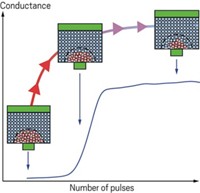Advertisement
Grab your lab coat. Let's get started
Welcome!
Welcome!
Create an account below to get 6 C&EN articles per month, receive newsletters and more - all free.
It seems this is your first time logging in online. Please enter the following information to continue.
As an ACS member you automatically get access to this site. All we need is few more details to create your reading experience.
Not you? Sign in with a different account.
Not you? Sign in with a different account.
ERROR 1
ERROR 1
ERROR 2
ERROR 2
ERROR 2
ERROR 2
ERROR 2
Password and Confirm password must match.
If you have an ACS member number, please enter it here so we can link this account to your membership. (optional)
ERROR 2
ACS values your privacy. By submitting your information, you are gaining access to C&EN and subscribing to our weekly newsletter. We use the information you provide to make your reading experience better, and we will never sell your data to third party members.
Materials
Silicon-Based Spintronics
Study demonstrates flow of electron spin in workhorse material
by Mitch Jacoby
May 21, 2007
| A version of this story appeared in
Volume 85, Issue 21
In a development that may pave the way for new types of microelectronic devices, researchers have demonstrated that electron spin can be transported and manipulated in silicon. The study may enable future spintronics (spin-based electronics) products to be fabricated from the most ubiquitous material in the microelectronics industry: silicon.
At the heart of the study is a test device that transports electron spin (designated as spin "up" or spin "down") across a silicon substrate and detects the spin at the other side. The device features a novel design that consists of an electron emitter and a silicon film that is sandwiched between a pair of ferromagnetic materials, Co84Fe16 and Ni80Fe20, which serve as spin filters that can be activated independently.
As electrons impinge upon the CoFe material, only one orientation of spin passes through to the silicon film. Electrons with the opposite spin are blocked. In a similar way, as the electrons reach the NiFe material, that filter transmits either all or none of the electrons depending on the orientation of their spins. By applying a magnetic field and measuring its influence on the current, Ian Appelbaum, an assistant professor of electrical and computer engineering at the University of Delaware, and graduate student Biqin Huang, along with Douwe J. Monsma of Cambridge Nanotech, in Cambridge, Mass., directly observe electron-spin transport through the silicon film. They report their findings in Nature (2007, 447, 295).

Nowadays, commercial semiconductor chips come packed with millions of transistors and other components. Yet for all the progress in manufacturing and miniaturization technology, nearly all of today's circuits, like those of earlier decades, rely solely on the flow of electrical charge to trigger switches or to carry out other functions.
Proponents of spintronics suggest that electron spin, a fundamental property closely associated with magnetism, could be exploited in tandem with electrical charge such that electron current could carry more information than it does in charge-only circuitry. As such, spintronic circuits could play a central role in a future generation of advanced computers and other microelectronic devices (C&EN, Aug. 28, 2006, page 30).
Commenting in the same issue of Nature, Igor  uti
uti and Jaroslav Fabian, physicists at the State University of New York, Buffalo, and the University of Regensberg, in Germany, respectively, note that in order for that type of advanced circuitry to materialize, "spintronics must conquer silicon," because it is the abundant, inexpensive, and entrenched material of choice for conventional semiconductor microelectronics.
and Jaroslav Fabian, physicists at the State University of New York, Buffalo, and the University of Regensberg, in Germany, respectively, note that in order for that type of advanced circuitry to materialize, "spintronics must conquer silicon," because it is the abundant, inexpensive, and entrenched material of choice for conventional semiconductor microelectronics.
Previous attempts by other researchers to transport electron spin through silicon have produced inconclusive results,  uti
uti and Fabian note. In contrast, the current study provides "convincing proof," they say.
and Fabian note. In contrast, the current study provides "convincing proof," they say.





Join the conversation
Contact the reporter
Submit a Letter to the Editor for publication
Engage with us on Twitter